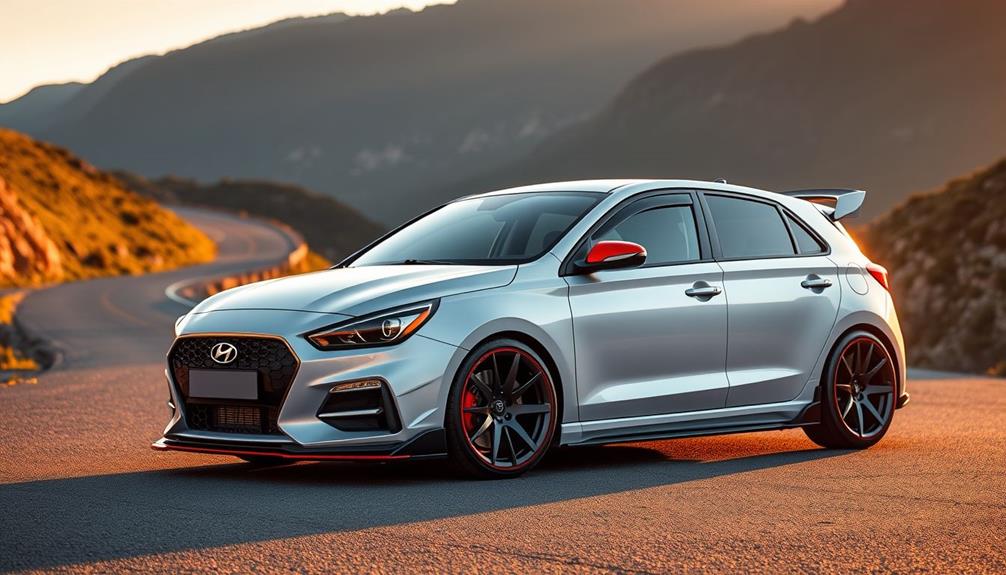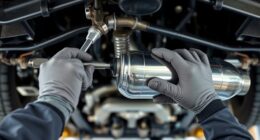Tuning your Hyundai I30 can transform your hatchback into a modern performance machine. By adjusting boost levels and recalibrating the engine management system, you can gain up to 271bhp and improve acceleration. Utilizing advanced tuning technologies, such as performance chips, you'll find tailored options to enhance power and efficiency. Easy installation means you could be enjoying increased torque and grip in no time. Plus, connecting via smartphone allows real-time adjustments to match your driving style. If you're keen to know more about tuning options and community insights, there's plenty more to explore.
Key Takeaways
- Tuning the Hyundai i30 can boost horsepower from 245bhp to 271bhp, and up to 300PS with modifications.
- Optimizing boost levels from 13 psi to 16 psi enhances acceleration and overall driving dynamics.
- ECU remapping and using high ethanol content fuels like E85 can yield power gains of 5% or more.
- Performance chips offer customizable tuning options, including Efficiency, Sport, and Race modes for tailored driving experiences.
- Community insights and dyno testing validate tuning claims, ensuring transparency and best practices for enthusiasts.
Overview of Hyundai I30 Tuning
When it comes to tuning the Hyundai i30, what kind of performance improvements can you expect? You'll be pleased to know that with effective tuning strategies, you can boost your i30N's output from 245bhp to around 271bhp, and even reach up to 300PS (220KW) with the right modifications.
By refining boost levels, you can elevate pressure from 13 psi to 16 psi, which greatly enhances acceleration and overall driving dynamics.
Additionally, recalibrating your engine management system is vital, especially if you decide to use fuels like E85. This tuning can yield power gains of 5% or more for turbocharged engines, making your driving experience even more exhilarating.
The i30 N's advanced driving modes and configurable settings allow you to customize your performance to suit your driving style, adding to the excitement of tuning.
However, keep in mind that managing torque-steer and understeer is necessary when increasing power levels. Engaging with tuning communities will provide you with shared experiences and tips, ensuring you make informed decisions for peak performance enhancements.
Tuning Technologies Explained
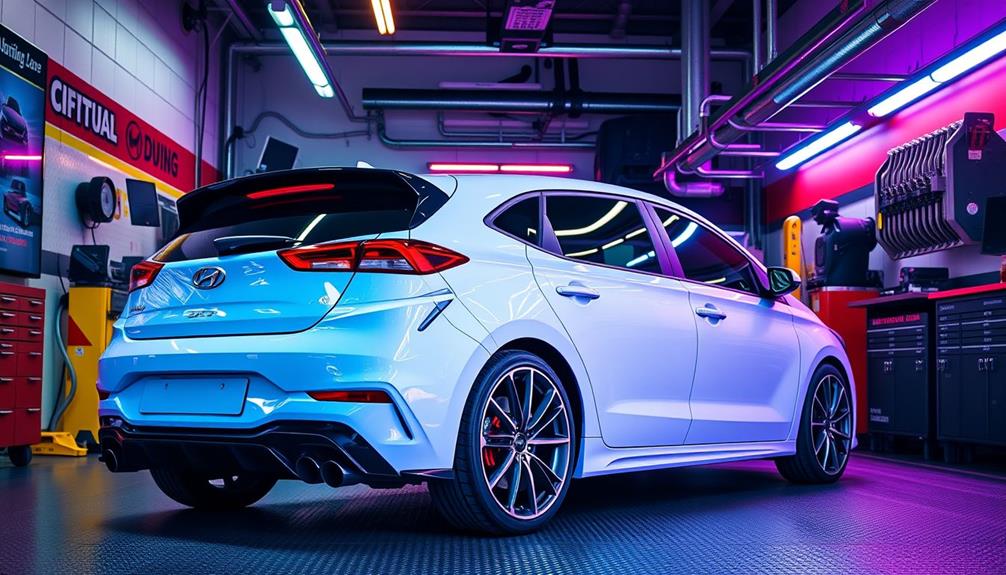
When tuning your Hyundai i30, understanding the differences in injection systems can make a big difference in performance.
Performance chip options, like RaceChip, allow you to customize your engine's output for ideal gains.
Injection System Differences
Fuel injection systems play an essential role in the performance tuning of modern vehicles, particularly in the Hyundai I30. When tuning your hot hatch, understanding the differences between injection systems can greatly impact your results.
The two main technologies you'll encounter are Common Rail (CR) and Pumpe-Düse (PD). CR systems, identifiable by four characters in engine codes, allow multiple injections per cycle, enhancing combustion efficiency. This makes them a popular choice for performance tuning, especially in diesel engines.
On the other hand, PD systems, denoted by three characters, deliver direct fuel injection into the combustion chamber. Although slightly older technology, PD systems can also be optimized through tuning to boost torque and horsepower. This is particularly beneficial for vehicles equipped with 2.0 TDI engines.
Effective performance tuning can lead to substantial improvements, achieving up to 15% increases in fuel efficiency alongside notable gains in horsepower and torque.
The choice of tuning chip is vital, as it tailors adjustments based on the specific injection system. By understanding these differences, you can maximize your Hyundai I30's performance potential and enjoy a thrilling driving experience.
Performance Chip Options
With a wide range of performance chip options available for the Hyundai I30, you can greatly enhance your vehicle's horsepower and torque. For instance, tuning the i30 N can boost its horsepower from 275 to around 300, giving you a noticeable edge in performance.
Here are three key performance chip options to evaluate:
- Base Performance Chips: Ideal for everyday driving, these chips provide a decent boost without compromising reliability.
- RaceChip: This advanced option offers multiple tuning stages—Efficiency, Sport, and Race—allowing you to tailor your performance based on your driving style. Plus, it features real-time fine-tuning and automatic software updates.
- Premium Options: These chips deliver maximum power and torque enhancements, perfect for track enthusiasts who want to push their limits.
Installation is a breeze, thanks to the Plug&Drive principle, enabling quick self-installation in just minutes with the provided wiring kits.
Some performance chips even come with engine warranty options up to €10,000, giving you peace of mind as you upgrade your i30.
With the right performance chip, you're set to elevate your driving experience considerably.
Performance Gains From Tuning
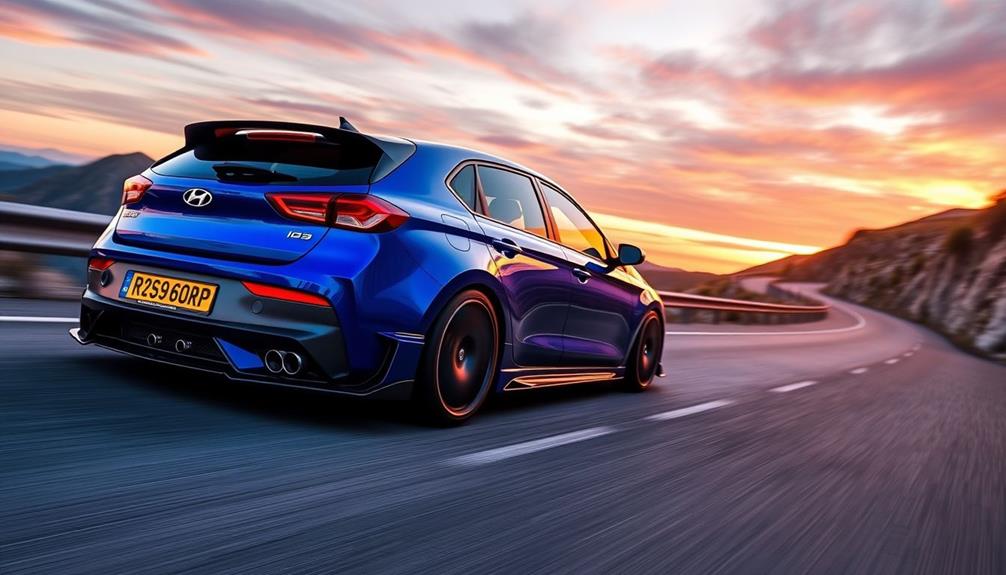
Tuning your Hyundai i30 N can release impressive performance gains that make every drive exhilarating. By increasing the horsepower from the stock 275 to around 300, you'll notice a significant boost in acceleration.
With enhanced tuning, torque output can jump from 400 Nm to approximately 500 Nm, giving you better grip during high-speed driving and reducing wheel spin.
Modifying boost levels is another key aspect of tuning. You can push your i30 N's boost from the standard 13 psi to 16 psi, optimizing engine performance for that thrilling rush.
Adding components like a large forge intake and a blow-off valve not only enhances the engine's sound but also elevates the overall driving experience.
To guarantee these modifications work harmoniously, ECU remapping is essential. This step assures compatibility with any altered fuel characteristics, especially when you're using higher ethanol content fuels like E85.
By implementing these tuning strategies, you're not just improving numbers on paper; you're transforming your driving experience into something truly unique and enjoyable.
Embrace the enhancements, and feel the difference every time you hit the road.
Software and Hardware Features
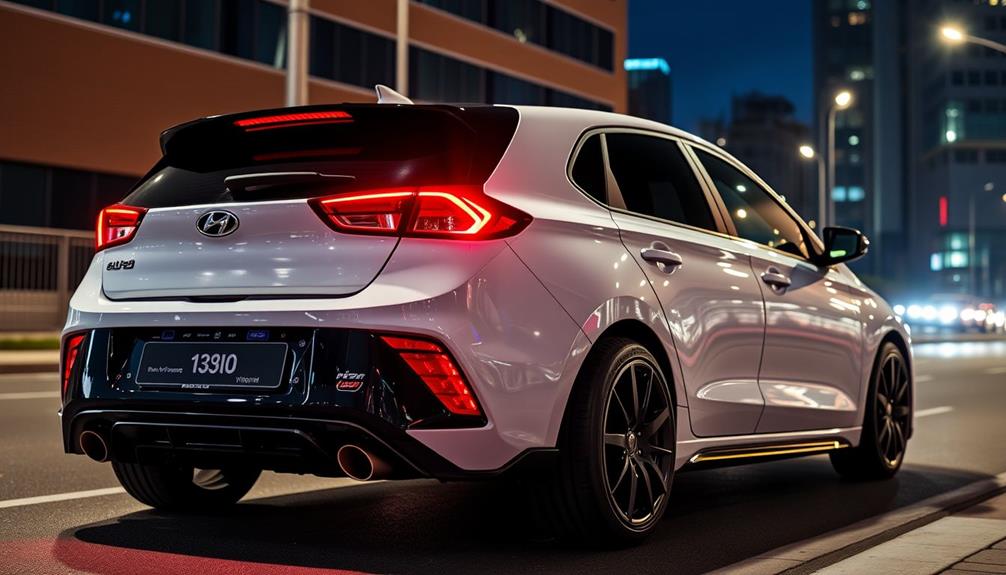
When tuning your Hyundai i30, taking advantage of motor-specific software can greatly enhance your engine's performance.
You'll also appreciate the advanced processor specifications that allow for precise adjustments, ensuring your car runs smoothly.
Plus, the easy installation process means you can get started quickly without any hassle.
Motor-Specific Software Customization
Motor-specific software customization plays an essential role in enhancing the performance of your Hyundai i30. This tailored software maximizes your engine's unique configurations, making your driving experience smoother and more dynamic.
By leveraging an ARM Cortex-M3 processor, the tuning software integrates seamlessly with your vehicle's hardware, delivering really good results.
Here are three key benefits of motor-specific software customization:
- Precision Tuning: With channel capacity varying from 3 to 7 analogue and digital channels, you can make precise adjustments based on your performance needs.
- User-Friendly Installation: The Plug&Drive principle simplifies the installation process. You'll find easy-to-follow manuals and wiring kits to get you set up quickly.
- Real-Time Adjustments: The RaceChip app lets you make real-time adjustments, choosing between Efficiency, Sport, and Race modes for peak performance.
Advanced Processor Specifications
With cutting-edge technology at its core, the advanced processor specifications of the Hyundai i30's tuning modules take performance to the next level.
These modules employ an ARM Cortex-M3 processor, which enhances your engine management system's tuning capabilities considerably. This powerful processor guarantees that you get precise control over your engine settings, allowing for ideal performance adjustments.
Depending on the variant of the tuning chip you choose, you can access between 3 to 7 analogue and digital channels. This flexibility means you can tailor adjustments to suit various engine configurations, maximizing your i30's potential.
The tuning modules are designed to withstand demanding performance conditions, housed in ultra-resistant composite materials that assure durability and longevity.
Each tuning solution comes equipped with motor-specific software, guaranteeing that the performance enhancements you receive are perfectly tailored for your i30's unique specifications.
This attention to detail ensures you get the most out of your hatchback. With these advanced processor specifications, your Hyundai i30 isn't just a car; it's a powerhouse of personalized performance, ready to elevate your driving experience.
Easy Installation Process
The installation process for tuning your Hyundai i30 is incredibly straightforward, thanks to the Plug&Drive principle. You can set it up in just a few minutes, making it accessible even if you don't have extensive technical knowledge. Each tuning chip comes with a thorough installation kit, ensuring you have everything you need to get started.
Here are three key features that simplify the process:
- User-Friendly Kits: Each kit includes wiring components and detailed user manuals, guiding you step-by-step through the installation.
- Durable Design: The tuning modules are housed in ultra-resistant composite materials, protecting them from wear and tear during performance enhancements.
- Smartphone Control: With the RaceChip app, you can adjust tuning features in real-time directly from your smartphone, allowing for personalized driving experiences.
This combination of easy installation, durable components, and added tech control makes tuning your Hyundai i30 not just efficient but also enjoyable.
You'll be amazed at how quickly you can elevate your driving experience with these enhancements!
Installation Process Simplified

Installing tuning modules for your Hyundai I30 is a breeze thanks to the Plug&Drive principle. You won't need professional assistance because the installation process is designed for easy, self-installation in just a few minutes. Each kit comes with thorough wiring kits and user manuals, making it accessible even if you have minimal technical knowledge.
The ultra-resistant composite housing of the tuning modules guarantees they can withstand the demanding conditions of your engine environment, enhancing durability and longevity. You can feel confident knowing that this upgrade is built to last.
Flexibility is another standout feature. If you ever decide to change vehicles, specific chips allow for reprogramming, so you can adapt your tuning setup without any hassle. This user-friendly option means you won't be left in the lurch when the time comes for a new ride.
The process is further enhanced by smartphone integration. While we won't explore that just yet, it's important to note that managing and adjusting tuning settings can be done seamlessly.
With these features, you're well-equipped to elevate your driving experience effortlessly.
App Control and Connectivity

With the RaceChip app, you can seamlessly integrate your smartphone to control tuning features right at your fingertips.
This allows you to make real-time adjustments to your Hyundai I30's performance, customizing your driving experience like never before.
Whether you want to switch between Efficiency, Sport, or Race modes, the app makes it easy and convenient.
Smartphone Integration Features
Releasing the full potential of your Hyundai I30 has never been easier, thanks to advanced smartphone integration features.
With the RaceChip app, you can control tuning enhancements directly from your smartphone, making it simple to maximize your driving experience. Plus, compatibility checks guarantee it works seamlessly with a range of mobile devices.
Here are three standout features that enhance your driving experience:
- Throttle Response Adjustment: The RaceChip XLR5 lets you fine-tune your throttle response, allowing for a personalized experience that suits your driving style.
- Real-Time Adjustments: The app's LCD controller provides real-time adjustments, making it easy to interact with your tuning settings while driving.
- Bluetooth Connectivity: Integrated Bluetooth allows for effortless setup and modifications right from the driver's seat, eliminating the hassle of physical connections.
With the ability to select from three tuning stages—Efficiency, Sport, and Race—you can easily switch between performance levels based on your needs.
The RaceChip app even offers automatic software updates, guaranteeing you always have the latest enhancements for peak performance.
Embrace the future of driving with these innovative smartphone integration features!
Real-Time Tuning Adjustments
Real-time tuning adjustments have revolutionized how you interact with your Hyundai I30, giving you the power to instantly modify performance settings right from your smartphone. With the RaceChip app, you can easily control tuning enhancements and guarantee seamless integration with your mobile device.
Using the RaceChip XLR5, you can fine-tune your throttle response settings, allowing for a personalized driving experience that fits your preferences. The app offers three tuning stages—Efficiency, Sport, and Race—enabling real-time adjustments and automatic software updates to keep your vehicle performing at its finest. Bluetooth connectivity makes setup and adjustments a breeze, allowing you to make changes right from the driver's seat.
Here's a quick overview of the key features:
| Feature | Description |
|---|---|
| Tuning Stages | Efficiency, Sport, Race |
| Throttle Response Control | Personalized adjustments for peak driving experience |
| Performance Monitoring | Track metrics and make instant adjustments |
With its user-friendly interface, the RaceChip app empowers you to adapt to changing driving conditions and preferences effortlessly.
Warranty and Support Options

When evaluating tuning options for your Hyundai I30, understanding the warranty and support available can greatly enhance your experience. Choosing a reliable tuning solution like RaceChip means you can enjoy peace of mind with their product warranty, which ranges from 2 to 5 years depending on the chip model.
If you're looking to boost your performance even further, you can opt for an additional engine warranty that covers up to €10,000 based on selected features.
Here are some key support options to evaluate:
- Reprogramming for New Vehicles: If you change cars, certain chip models allow you to transfer your tuning benefits, so you won't lose your investment.
- Customer Service Access: You'll have support for any tuning inquiries, warranty claims, or installation assistance, ensuring a smooth experience as you tune your I30.
- Shipping and Returns: Enjoy free shipping within Europe and a 30-day return policy, enhancing your confidence in your purchase.
With these warranty and support options, you can confidently enhance your I30's performance, knowing you're backed by a reliable service.
Community Insights and Experiences
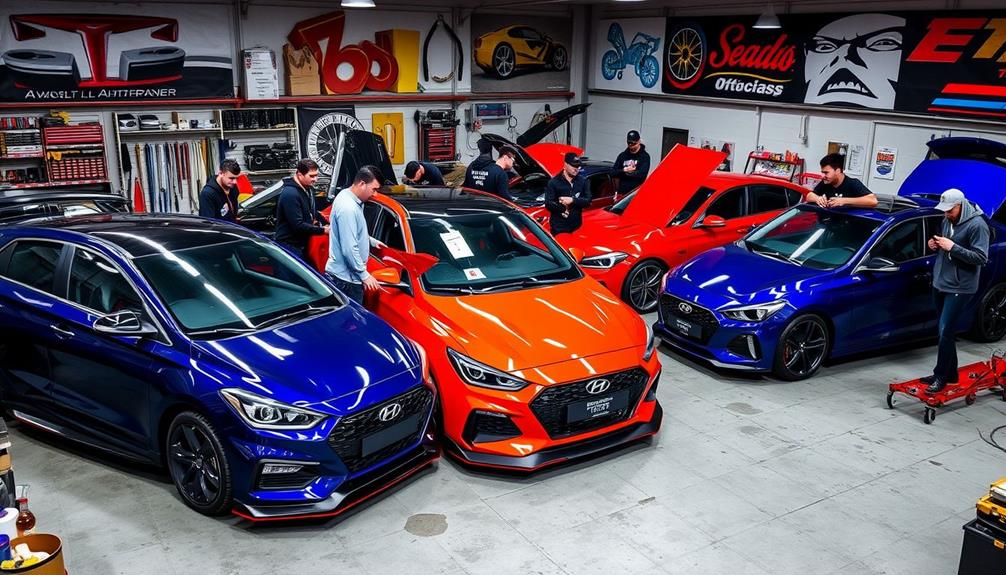
For Hyundai I30 enthusiasts, the community offers invaluable insights and shared experiences that can greatly influence your tuning journey.
The i30 Owners Club serves as a vibrant platform where over 758 members actively discuss various tuning topics. Here, you'll find real-world reports of impressive power increases, such as gains of up to 100kw at the wheels. This level of engagement not only highlights effective tuning strategies but also builds a sense of credibility through shared accomplishments.
Many users rely on dyno testing to validate their tuning claims, ensuring that the performance improvements they report are backed by numbers. This transparency fosters trust within the community, allowing you to make informed decisions about your own modifications.
While discussions often touch on the impact of E85 fuel, it's vital to note that the community is equally focused on various tuning techniques applicable to all setups.
Additionally, the forum is an excellent resource for troubleshooting and advice. Whether you're seeking clarification on a specific modification or looking for best practices, collaborating with fellow enthusiasts can elevate your Hyundai I30 tuning experience to new heights.
E85 Fuel and Performance Benefits

Releasing the full potential of your Hyundai I30 can be achieved by tapping into the benefits of E85 fuel. This blend of 85% ethanol offers a high octane rating of 107, making it ideal for turbocharged engines. By switching to E85, you can experience considerable performance enhancements that elevate your driving experience.
Here are three key benefits of using E85 fuel:
- Increased Power: You can expect power gains of 5% or more, thanks to improved combustion efficiency and higher timing adjustments compared to standard petrol.
- Enhanced Efficiency: The increased air density from turbocharging with E85 boosts engine efficiency and overall power output, giving you that extra thrill on the road.
- Recalibrated Performance: To maximize these gains, you'll need to recalibrate your engine management system and possibly install a different fuel sensor, ensuring compatibility with E85's unique characteristics.
While E85 can considerably enhance performance, be mindful that it might increase engine strain and reduce longevity.
Balancing performance and reliability is key to enjoying the full benefits of E85 in your Hyundai I30.
Future Trends in Tuning
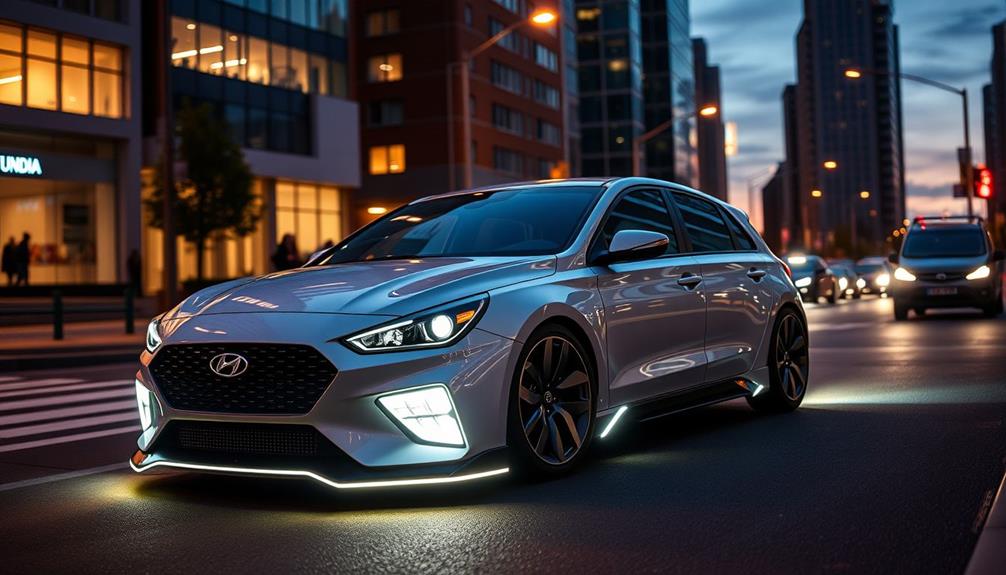
Tuning for vehicles like the Hyundai I30 is evolving rapidly, with a strong focus on optimizing performance while ensuring reliability. Advanced tuning chips are becoming more popular; they increase horsepower without risking engine integrity. As smartphone integration and tuning apps rise in prominence, you'll find it easier to make real-time adjustments to throttle response and performance settings directly from your device.
Anticipated official remaps from Hyundai aim to meet consumer demands for greater efficiency and power output in modern hot hatches. Plus, the ongoing discussions in automotive communities emphasize the importance of dyno testing and data sharing. This fosters a culture of transparency and collaboration among enthusiasts, enabling you to validate tuning claims and improvements.
Lastly, with alternative fuels like E85 gaining traction, you'll see tuning strategies adapting to recalibrate engine management systems, maximizing performance gains while addressing the challenges of higher ethanol content.
| Future Trends in Tuning | Impact on Hyundai I30 |
|---|---|
| Advanced tuning chips | Enhance horsepower reliably |
| Smartphone tuning apps | Real-time performance adjustments |
| Official remaps from Hyundai | Tailored performance enhancements |
| Alternative fuels (E85) | Requires recalibration strategies |
Frequently Asked Questions
Can You Modify a Hyundai I30?
Yes, you can definitely modify a Hyundai i30. With options like ECU remapping, upgraded exhaust systems, and boost adjustments, you'll enhance its performance and personalize your driving experience for better power and responsiveness.
Is Hyundai I30 Fast?
Yes, the Hyundai i30 is fast. With a 0-100 km/h time of just 6.1 seconds and impressive horsepower, you'll enjoy a thrilling driving experience that competes well with other hot hatches in its class.
Why Was Hyundai I30 Discontinued?
You might find that the Hyundai i30 was discontinued due to declining sales, shifting consumer preferences towards SUVs, and regulatory pressures. This allowed Hyundai to focus resources on developing newer, more popular models, including electric vehicles.
What Is the Most Powerful Hyundai I30?
Imagine a lion in a compact jungle; that's the Hyundai i30 N. With 275 horsepower ready to roar, it can release nearly 300 horsepower through tuning, making it the mightiest in the i30 family.
Conclusion
In the world of Hyundai i30 tuning, you're not just enhancing your hatchback; you're revealing its true potential. With a little attention, your ride can transform from ordinary to extraordinary, offering a driving experience that's simply exhilarating. Embracing the latest technologies and community insights, you'll find that the journey of tuning is as rewarding as the destination. So, why not give your i30 the gentle nudge it deserves and enjoy the thrilling ride that follows? With the addition of modern performance upgrades, such as enhanced suspension, exhaust systems, and engine tuning, your Hyundai i30 can achieve new levels of power and agility. These upgrades not only improve the overall performance of your hatchback but also add a touch of personalization, making your ride truly one-of-a-kind. So, take the leap and explore the endless possibilities of Hyundai i30 tuning, and experience a driving sensation like never before.
